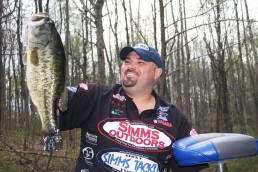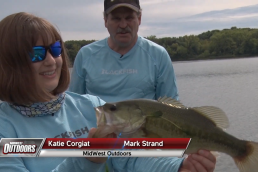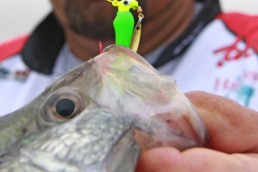‘Show Me State’ Late-Transition Bass
SHARE THIS POST
Missouri is known as the Show Me State, and while fishing opportunities abound in this beautiful place, many anglers we talk with struggle to consistently put good quality bass in the boat as fall fades to winter. Being versatile, and making some adjustments to your fishing game, can put you on bass even as most anglers hang up their rods until spring.
Depth & location
During all transition periods throughout the year, fish are in fact in transition. This is often overlooked by anglers, and may contribute greatly to tougher days on the water. Of course, there are no hard and fast rules in the wild, and fish, like all creatures, alter their habits based on their clocks, not ours. But, as a general rule of thumb, fall means shallow-water fishing, while winter means deep-water fishing; and fall means targeting confined locations, while winter means fishing open expanses.
Quite simply, in most reservoirs, as summer fades to fall, large concentrations of shad, shiners and other baitfish species migrate away from deep, open main-lake areas, and main-river channel areas, toward shallow confined locations. These include lake and reservoir creek arms, coves, pockets and bays, or in the case of major rivers, into feeder streams, cuts, side channels and oxbows that are still connected to the river. Later, as the weather changes with the season and the air and water temperatures plummet, bass and bait will begin to slowly filter out of these shallow confined areas, where they spent most of fall. As they do, they move back out toward the deep and wide-open expanses of main-lake and main-river areas, where they will spend most of the frigid water season.
Speed & presentation
During fall, fish tend to be more active more often, while during winter, fish tend to be a bit more lethargic. When water temperatures hover in or near the preferred range of bass, their bodies become more efficient at utilizing the prey that they eat, allowing them to attain maximum size and optimal health. Higher-speed presentations and power fishing tactics shine at this time of year. A high-speed, erratic retrieve is effective much of the time in fall. Spinnerbaits, buzzbaits, shallow diving crankbaits and lipless cranks are all top options. Swim jigs with swimming style soft plastics, such as paddle tail shads and curly tail grubs, are also highly effective. So are short-lipped floating minnow lures and vibrating blade baits fished as a quick speed.
In the colder weather and water of early winter, these patterns can sometimes produce bass, especially on warmer sunny afternoons with winds out of the west or south. But, oftentimes, it seems as if the bass get a case of lock jaw. When this happens, slowing down can be all it takes to trip their trigger. Slow-rolling heavy spinnerbaits in deep water, or slow-cranking with big-lipped divers can produce well. Slowing down the blade bait and working it with a lift-and-drop technique can be highly effective. Slowly working bottom structure with heavy jigs and weighted plastics, hopping, dragging and even dead sticking them, depending on how inactive the fish are, can be the hot ticket in the cold waters.
Vertical jigging spoons over schools of fish can load the boat at times. This is also when suspending jerkbaits start to come into their own, with varying lengths of pauses, sitting in a bass’s face, until it pounces like a cat on a mouse. The colder the water gets, the more likely that slower and more subtle techniques will be required for consistent success.
Putting it together
Its always a good idea to start out a day of fishing aggressively. By selecting power fishing lures and tackle, changing spots often, staying on the trolling motor, and covering massive amounts of water quickly, you put a bait in the faces of more fish. If fish are shallow, and in an active feeding mode, this tactic will nearly always be the most productive option. Even when fish are in a neutral feeding mode, this tactic often outproduces slower tactics, as long as significant concentrations of fish are located in shallow enough water for high-speed fishing.
Are you enjoying this post?
You can be among the first to get the latest info on where to go, what to use and how to use it!
When fish are in a negative feeding mode, however, these methods become much less an option. Sure, anglers can sometimes trigger reactionary strikes with a high-speed approach. But, slowing down and finessing the fish is usually a better option. Additionally, once the bulk of fish drop down into deep water, high-speed tactics become more limited. Deep water and fast fishing don’t exactly go hand-in-hand. So, start shallow and aggressive, being ready to move into deeper water with slower presentations.
Top waters
Favorite places around the state for scoring numbers of good quality bass at this time of year include massive reservoirs like Mark Twain, Table Rock and Lake of the Ozarks, as well as some smaller lakes like Clearwater, Blue Springs and Hazel Creek Lake. Big rivers like the Missouri and Mississippi, the smaller rivers and big creeks that feed into them, and their connected oxbow lakes give up big bass. But don’t forget about farm ponds and small lakes and streams—especially those that receive little fishing pressure. These can be gold mines at this time of year.
Get out there
Don’t rush to store the boat and stow the gear just because the mornings get chilly. Big bass await. Breath the crisp and clean air of late fall and early winter deep into your lungs and venture out onto the water and into the wilderness for another foray at the hobbies, sports and traditions we so love. Follow this plan of attack until you find which stage of the transition that the bulk of the bass have settled into. Then let the Show Me State show off the excellent bass fishing that it’s capable of producing as you soak up some more grip and grin time, while the rest of the fishing crowds are working on their cases of cabin fever. What are you waiting for?
Become a MidWest Outdoors Insider here!
MWO
SHARE THIS POST
Did you enjoy this post?
You can be among the first to get the latest info on where to go, what to use and how to use it!
Colby Simms
Colby Simms is a professional fisherman, media personality, guide and owner of Colby Simms Outdoors Group. He runs a guide service booking guided fishing and hunting trips, and sells tackle. Contact him at colbysimmsoutdoors@hotmail.com, Facebook @ColbySimmsOutdoors and @ColbySimmsSportFishingPro, or 618-521-0526 or 573-358-5948.



